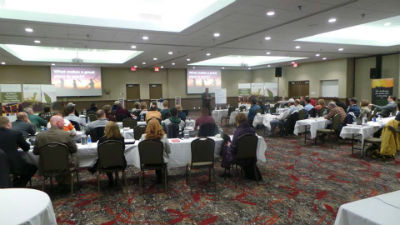 Farming is changing…how do you develop your Edge? Water Street EDGE farm seminar attendees at the Willmar, MN event on February 16th & 17, 2015, learned the skills needed to lead and manage their farm operations in the future. They were engaged in interactive educational sessions, participated in 1-on-1 conversations, and took advantage of networking opportunities.
Farming is changing…how do you develop your Edge? Water Street EDGE farm seminar attendees at the Willmar, MN event on February 16th & 17, 2015, learned the skills needed to lead and manage their farm operations in the future. They were engaged in interactive educational sessions, participated in 1-on-1 conversations, and took advantage of networking opportunities.
We value farming as a business and understand how vital education is for future success and advancing technologies. Therefore, we were honored to have the opportunity to co-sponsor the Water Street Edge event with Water Street Solutions. We wanted to ensure that farm businesses and families in south-central Minnesota and surrounding areas had this educational opportunity available to them.
For those of you who were unable to attend, we wanted to share some seminar highlights with you, and what better way to do that than by using technology. Social media is other technology that is fast becoming a part of the future of farming.
Water Street EDGE Tweets
During the event we used the #WaterStreetEDGE to tweet important take-home tidbits from each speaker and session. Here’s some highlights.
Unless we have plans that turn into hard work…they are just good intentions! @DeanHeffta #WaterStreetEDGE pic.twitter.com/ui8ElNcFe8
— Corn Capital (@corncapital) February 17, 2015
Check out the US balance sheet at http://t.co/4uWtaXvaE8; a dynamic website showing you what the numbers are doing. #WaterstreetEdge — Corn Capital (@corncapital) February 16, 2015
Finance plan – make sure you have a little stretch in your waistband. Dr. David M. Kohl #WaterStreetEdge #AgFinance pic.twitter.com/Hvc0emX2oc
— Corn Capital (@corncapital) February 17, 2015
Build a connection with the next generation of landlords. Show them what it means to be a famer! @DeanHeffta #WaterStreetEDGE — Corn Capital (@corncapital) February 17, 2015
Follow us on Twitter @corncapital for more educational information, photos from the field and tweets from the tractor!
Photo Gallery
Here’s a visual tour of the event. We had a great time connecting with all of the farmers, both new and familiar faces! Take a look.
Thank You from Corn Capital Innovations
Most importantly, we want to give a big thank you to all the speakers, panelists, attendees and coordinators of this event! It’s wonderful to be part of a group of agricultural leaders who support ag education and contribute to the future of farming.







































